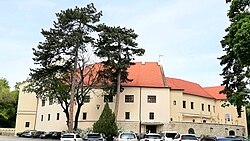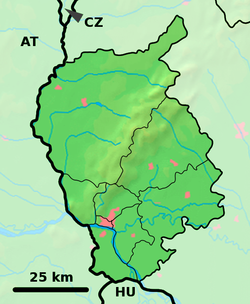Pezinok
Pezinok | |
|---|---|
Town | |
 Pezinok castle | |
| Nickname(s): Pezinek, Pavúci | |
Location of Pezinok in the Bratislava Region | |
| Coordinates: 48°17′31″N 17°15′58″E / 48.29194°N 17.26611°E | |
| Country | Slovakia |
| Region | Bratislava |
| District | Pezinok |
| First mentioned | 1208 |
| Boroughs | Grinava, Cajla |
| Government | |
| • Mayor | Roman Mács |
| Area | |
| • Total | 72.76 km2 (28.09 sq mi) |
| (2022) | |
| Elevation | 151[2] m (495[2] ft) |
| Population | |
| • Total | 24,506 |
| • Density | 340/km2 (870/sq mi) |
| Time zone | CET (UTC+1) |
| • Summer (DST) | CEST (UTC+2) |
| Postal code | 902 01[2] |
| Area code | +421 33[2] |
| Car plate | PK |
| Website | www.pezinok.sk |

Pezinok (Slovak pronunciation: [ˈpezinɔk]; in the local dialect Pezinek; Hungarian: Bazin; German: Bösing; Latin: Bazinium) is a town in southwestern Slovakia. It is roughly 20 km (12.43 mi) northeast of Bratislava and, as of December 2023, had a population of 24,506.
Pezinok lies near the Little Carpathians and thrives mainly on viticulture and agriculture, as well as on brick-making and ceramic(s) production.
History
[edit]From the second half of the 10th century until 1918, it was part of the Kingdom of Hungary. Pezinok, or at least its surroundings, was for the first time mentioned in 1208 under name "terra Bozin". During the next few centuries, the town changed from a mining settlement to a vineyard town. It gained the status of a free royal town on 14 June 1647. Pezinok had its most glorious era of wealth and prosperity in the 17th and 18th centuries when it was also one of the richest towns in the Kingdom of Hungary. Its wealth was based on the production of quality wines. In the 19th century, the town slowly began to industrialize: the first sulphuric acid factory in Hungary or the known brickworks were established here. It boomed further after it was connected to the railway. After the breakup of Austria-Hungary in 1918/1920, the town became part of the newly created Czechoslovakia. In the first half of the 20th century, it was declining, vineyard production was declining, forcing many inhabitants to emigrate. It is growing again after the end of World War II.
Geography and tourism
[edit]Pezinok lies at an altitude of 152 metres (499 ft) above sea level and covers an area of 72.555 square kilometres (28.0 sq mi).[5] It is located in the Danubian Lowland at the foothills of the Little Carpathians, around 20 km (12.43 mi) north-east of Bratislava. Another major city, Trnava, is located around 25 km (15.53 mi) to the east.
A ski resort is situated on the Baba mountain. The neighbouring Little Carpathians offer numerous hiking paths. All of the city forests are part of the Little Carpathians Protected Landscape Area.
The Little Carpathians Museum (Malokarpatské múzeum), which is in a typical wine merchant's house in the centre of the town, was undergoing a major renovation in 2008 and promises to be one of the best small museums in Slovakia.
It has the biggest collection of wine presses in central Europe, some of them gigantic wooden affairs dating from the early seventeenth century; the atmospheric old cellars of the building are partly given over to an exhibition of them.
But Martin Hrubala, the deputy director of the museum, is keen to make the museum not just about the old but also the new: the entrance fee includes a wine tasting, accompanied by a sommelier. And the museum promises interactivity at a level unusual for Slovak museums. Visitors, for instance, as well as tasting wine will also get the opportunity to make their own.
Pezinok seems to have been investing heavily in public facilities lately: the city museum, in a building opposite the Little Carpathians Museum, opened in 2003. It features a range of attractively presented local archaeological finds and a selection of stonework salvaged from nearby churches; labelling, however, is in Slovak only.
And at the northern end of the city centre, next to a park which once formed its landscaped grounds, is Pezinok Castle. Originally a moated fortress which was later turned into a chateau for the aristocratic Pálffy family, the cellars of the castle are now home to the National Wine Salon.
Little Carpathians Museum (Malokarpatské múzeum) is situated in Pezinok.
Town suburbs
[edit]- Grinava historical suburb
- Town center
- Cajla historical suburb
- Sídliská:
- Sever (English: North)
- Juh (English: South)
- Muškát
- Záhradná (originally Stred)
- Za hradbami and 1. mája (originally Stred II.)
- Moyzesova (originally Prednádražie)
- Starý dvor (English: Old yard)
- Sahara
- Unigal
- Panholec
- Glejovka
- Čikošňa
- Turie brehy (English: Shores of cattles)
- Talihov dvor (English: Talih's yard; originally Nataliin majer)
- Recreation areas
- Kučišdorfská dolina (English: Kučišdorf Valley)
- Leitne
- Reisinger
- Slnečné údolie (English: Sun Valley)
- Stupy
Traditional Events
[edit]February
Ethnofestival
March
Selection of the Queen of wine
PAFF – alternative (amateur) film festival in House of Culture
April
Wine markets - international competition, exhibition and wine tasting
May
Ad Una Corda - International church choir festival {every even year}
Sponsorship march in support if UNICEF
June
Cibulák - theater festival
Competition of ancient cars
July
Slovakia Matador - competition of cars driving in The mountain {to the hill of Baba}
July - August
Promenade concerts take place as a part of Cultural sumer {every Sunday late afternoon}
Flamenco Verano summer flamenco school in Pezinok
August
Pezinský Permoník - Small Carpathian exhibition and bourse of minerals, fossils and precious stones connected with gold washing on the streets
Dychovky v preši - International festival of brass music
September
Vinobranie - celebrations of wine including rich cultural program and tasting of regional specialties{food and wine} in the streets of the city center
October
Pezinský strapec - International competition in ballroom dancing
November
St. Martin's blessings of wine includes tasting of young wine
Day of Open Cellars regional promotional wine tasting in private cellars
December
Christmas Inspirations - sell of Christmas goods Including cultural program on Radničné square and at Old Town hall
Gastronomy
[edit]In the past, the daily diet of local peasant families mainly included dishes based on flour such as knofle, osúchy, dolky, podlisníky, šiflíky, and potato mixture such as lokše, šuferle, gerheň, and scískance. The classic thick soups prepared mainly with beans or bean pods, lentils, peas, chickpeas or the integral horseradish soup were known and dill, pumpkin, potato, tomato or mushroom sauces or prívarky. At the time of pig slaughter, the so-called obarová polievka in which bread pieces were placed. At Easter, sourdough záviny filled with tvaroh, walnuts and poppy seeds, and veľkonočný baranček ("Easter lamb") were served. At Christmas, a vianočka and pupáky were served.
The traditional dish, lokše with goose or duck lard is shared with the nearby Slovenský Grob, and also part of the husacie or kačacie hody ("goose" or "duck festivals" – lokše with lard, roasted goose or duck and steamed red cabbage with strudel).
In the second half of August, since 2003, the fyzulnačka (in the Slovak literary language fazuľovica or fazuľová polievka, English: bean soup) cooking competition has been organized in the Town Hall Square (Slovak: Radničné námestie).
Typical drinks
[edit]The typical drink of the town is wine. In September, a burčiak is sold in Grinava and also during the Pezinok Grape Harvest Festival (Slovak: Pezinské vinobranie).
Demographics
[edit]| Year | Pop. | ±% |
|---|---|---|
| 1970 | 13,872 | — |
| 1980 | 17,116 | +23.4% |
| 1991 | 20,515 | +19.9% |
| 2001 | 21,082 | +2.8% |
| 2011 | 21,179 | +0.5% |
| 2021 | 24,900 | +17.6% |
| Source: Censuses[7][8] | ||
According to the 2001 census, the town had 21,083 inhabitants. 96.51% of inhabitants were Slovaks, 1.21% Czechs and 0.52% Hungarians.[5] The religious makeup was 64.83% Roman Catholics, 21.02% people with no religious affiliation, and 8.22% Lutherans.[5]
People
[edit]- Katarína Aulitisová
- Bekim Aziri
- Ján Bahýľ
- Juraj Bindzár
- Zuzana Čaputová
- Roman Féder
- Katarína Franklová
- Moritz Fuerst
- Eduard Chmelár
- Jaroslav Knil
- Ján Kupecký
- František Meissl
- Milan Mlsna
- Ján Baptista Najmar
- Karol Pekník
- Rudolf Pepucha
- Filip Polc
- Štefan Prokop
- Ľudovít Rajter
- Richard Réti
- Štefan Sandtner
- Lajo Slimák
- Dušan Slobodník
- František Srna
- Eugen Suchoň
- Ondrej Šteberl
- Ján Štohl
- Ján Štrba
- Emil Venkov
Twin towns — sister cities
[edit] Neusiedl am See, Austria
Neusiedl am See, Austria Mosonmagyaróvár, Hungary
Mosonmagyaróvár, Hungary Mladá Boleslav, Czech Republic
Mladá Boleslav, Czech Republic Kyjov, Czech Republic
Kyjov, Czech Republic Izola, Slovenia
Izola, Slovenia
References
[edit]- ^ Statistical Office of the Slovak Republic (www.statistics.sk). "Hustota obyvateľstva - obce". www.statistics.sk. Retrieved 2024-02-08.
- ^ a b c d "Základná charakteristika". www.statistics.sk (in Slovak). Statistical Office of the Slovak Republic. 2015-04-17. Retrieved 2022-03-31.
- ^ "Počet obyvateľov podľa pohlavia - obce (ročne)". www.statistics.sk (in Slovak). Statistical Office of the Slovak Republic. 2023. Retrieved 2024-08-10.
- ^ Pezinok antimony deposits at Mindat.org
- ^ a b c "Municipal Statistics". Statistical Office of the Slovak republic. Archived from the original on 2007-12-17. Retrieved 2007-12-19.
- ^ "Gastronómia". www.pezinok.sk (in Slovak). Retrieved 2024-09-07.
- ^ "Statistical lexikon of municipalities 1970-2011" (PDF) (in Slovak).
- ^ "Census 2021 - Population - Basic results". Statistical Office of the Slovak Republic. 2021-01-01.
- ^ "Partnerské mestá" (in Slovak). Pezinok. Retrieved 2019-09-03.
See also
[edit]External links
[edit]![]() Media related to Pezinok at Wikimedia Commons
Media related to Pezinok at Wikimedia Commons






